Last updated: November 21, 2025
Person
Octave Chanute
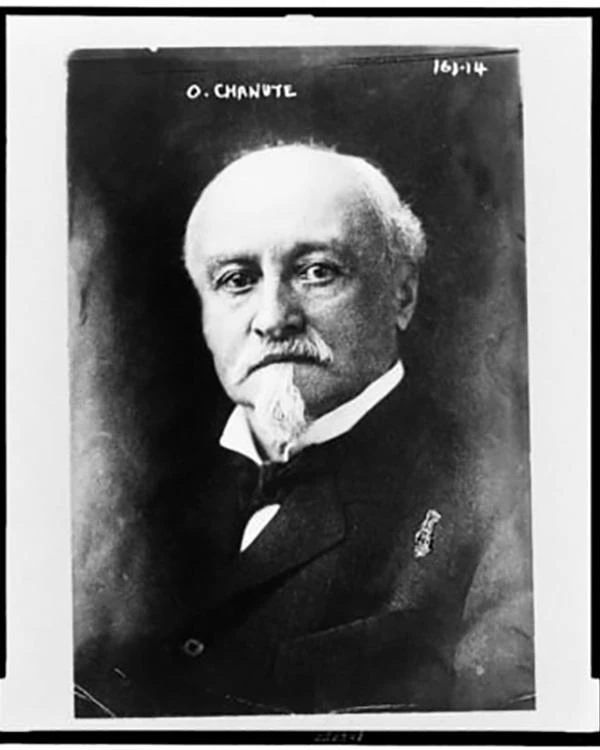
Library of Congress
“His writings were so lucid as to provide an intelligent understanding of the nature of the problems of flight to a vast number of persons who would probably never have given the matter study otherwise.”
-Wilbur Wright upon Chanute's death in 1910.
Born in Paris in 1832, Octave Alexandre Chanute migrated with his father to America at the age of 6. Son of a college professor, Chanute received private school education in New York and quickly began work in the engineering field as a surveyor in 1848 for the Hudson River Railroad. Over his career, Chanute built a reputation as one of the most successful engineers in America. Chanute served as President of several civil engineering organizations including the American Society of Civil Engineers and the Western Society of Engineers, among others. He was responsible for designing the first bridge over the Missouri River at Kansas City, and supervised the construction of railroads opening the West. Virtually every cow driven north from Texas passed through the stockyards in either Chicago or Kansas City, both designed by Chanute. His services as a civil engineer and urban planner were critical to the development of towns across the West.
By 1888, Octave Chanute, now one of the most successful civil engineers in the nation, had established both a consulting practice and a wood preservation firm in Chicago. At last he would have some spare time to pursue his hobby – flying machines. Chanute had been fascinated by the problem of flight for almost three decades. He had corresponded with virtually every major aeronautical experimenter in the world, and sponsored discussion of flight at important engineering conferences. The first fruit of his effort was the publication of Progress in Flying Machines in 1894. The most important book published on aviation up to that time, the volume provided a remarkably complete record of what had been accomplished in the past and pointed a way to the future.
By 1894, inspired by the work of the German glider experimenter Otto Lilienthal, Chanute began to develop his own glider designs capable of carrying human beings into the air. Anxious to provide employment for young flying machine enthusiasts, as well to advance his own work, he began contracting for the construction of his most promising glider designs.
Chanute selected the sand dunes along the southern shore of Lake Michigan as the perfect place to test his design ideas. The area was close to Chicago and sparsely populated, offering a number of important advantages including steady winds, dunes from which a glider could be launched in any direction, and an abundance of sand for soft landings.
On June 22, 1896, Chanute and his four assitants rode the Lake Shore railroad to Millers, Indiana; within the present city limits of Gary. The men caused a stir of excitement among the locals as they unloaded their odd-looking luggage and headed towards the lake. They used a lakefront area owned by "Squatter Queen" Druislla Carr. Upon reaching the dunes, they pitched their tents and assembled the first glider to be tested. Augustus Herring, the most experienced member of the group, had brought a glider based on the Lilienthal design. William Avery, a Chicago carpenter, had constructed, a multi-wing design to Chanute’s specifications, while William Butusov would attempt to launch his own glider, the Albatross, down a wooden ramp. Dr. James Ricketts, a Chicago physician with “a slack practice and a taste for aeronautics,” was on hand to provide emergency medical services.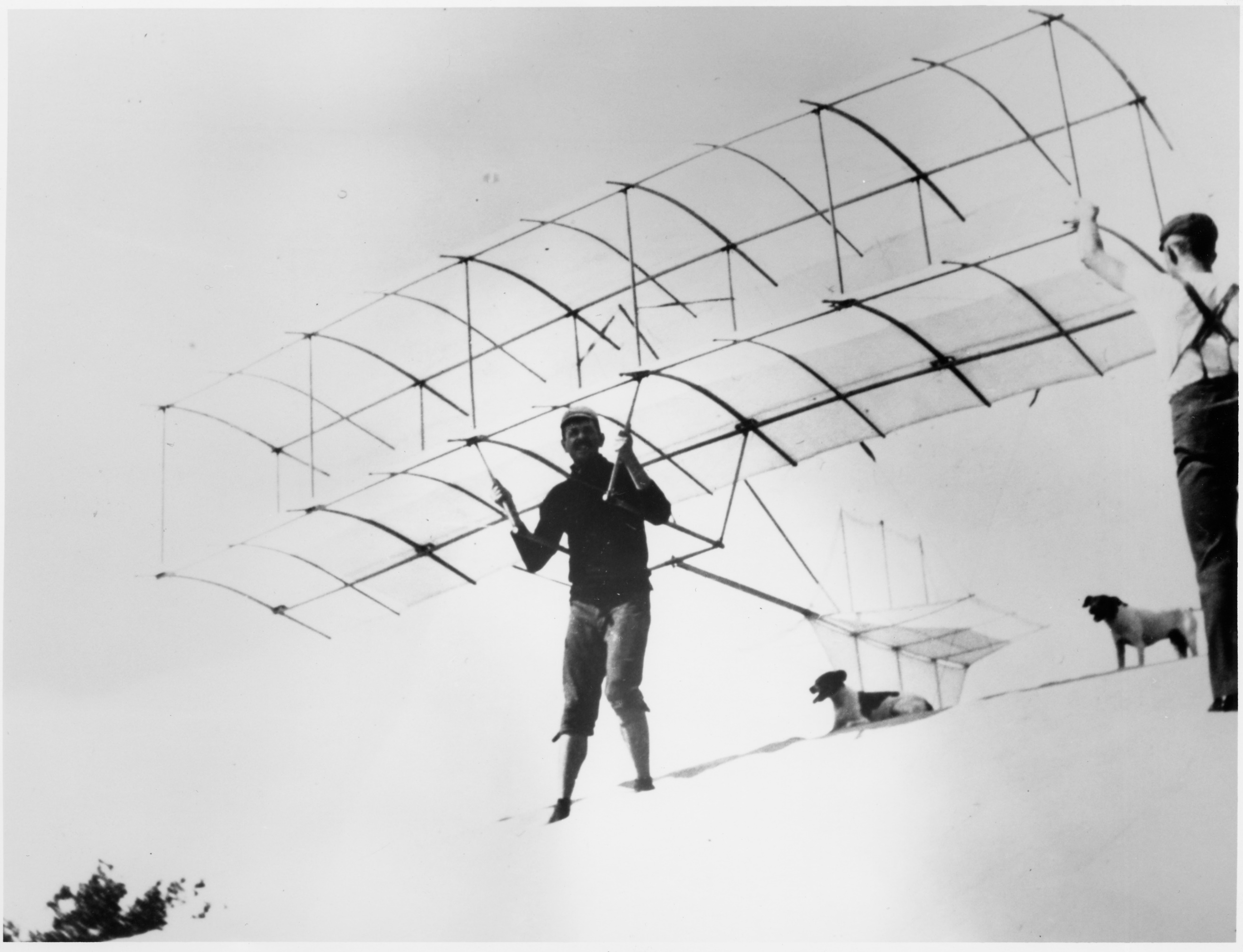
Caption: A pilot about to take off in the 1896 glider designed by Octave Chanute and Augustus M. Herring. Photograph courtesy of Smithsonian Institution. Alt Text: historic image of a man standing on a hill about to take off in a glider. The glider consists of two wings, one on top of the other and a tale/rudder at the back. The man is hanging from bars at the bottom of the glider. Another man and two dogs are also in the photo.
Herring and Avery did most of the flyings, turnings in a series of 50-60 foot jumps, with occasional glides of up to 116 feet. The group returned to Chicago on July 4th. They would spend the next month repairing their various craft, and building a new glider featuring three wings set one on top of the other and braced together with an innovative design, the Pratt truss configuration that Chanute had employed in constructing railroad bridges.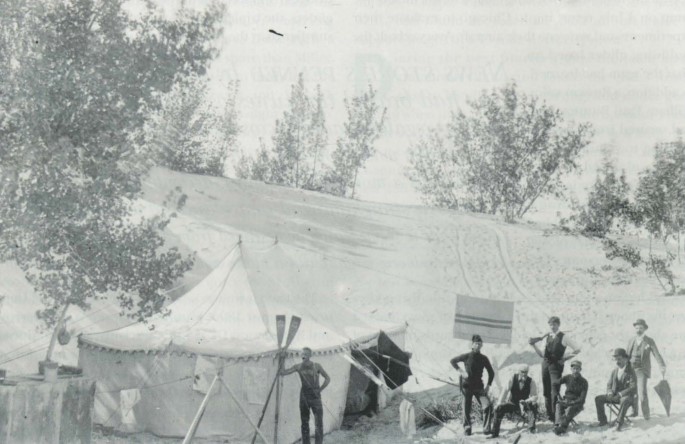
Caption: The Chanute camp in Dune Park, Indiana in September 1896. From left to right: Unknown, Augustus Herring, Octave Chanute, Henry S. Bunting (of the Chicago Tribune), William Paul Butusov, and two unidentified newspaper reporters. The team used a circus tent after a storm destroyed its original equipment. Photograph courtesy of the Library of Congress.
On August 21st, 1896, the five men established a camp some ten miles down the beach from their original site in Millers at a location known as "Dune Park" or the "Central Dunes." After some early disappointments, the team removed the bottom wing of the glider, repositioned the tail, resulting in the perfect biplane design. With that modification complete, Herring and Avery were soon making repeated flights of over 200 feet in length, traveling up to 358 feet through the air. When the group broke camp on September 26th, 1896 they had completed several hundred flights with the biplane. At that time, the little biplane was the most successful heavier-than-air flying machine in the world.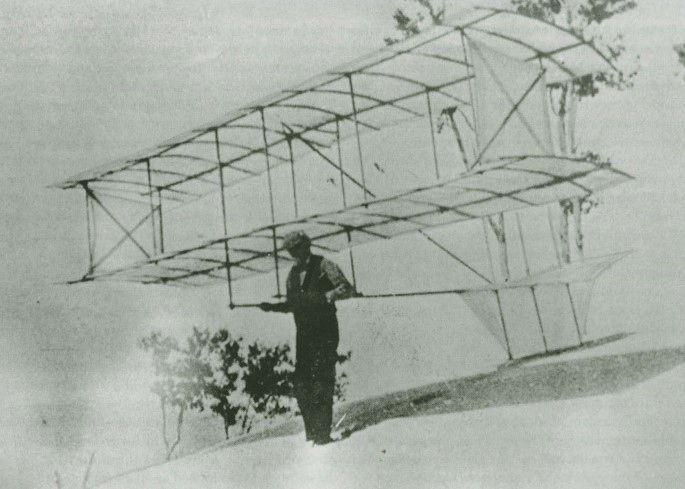
Caption: Octave Chanute holds his biwing glider design on top of a dune. At sixty-four years of age, Octave left the experimental "glides" to his younger companions. Photograph from Calumet Regional Archives, IU Northwest.
The 1896 Chanute-Herring biplane tested on the Indiana Dunes proved to be a key step on the road to the invention of the airplane. Herring continued to experiment with the design of his own over the next five years. Chanute’s publication of the plans and specifications for the glider sparked a renewed interest in flight both in America and Europe. Chanute work was able to encourage and attract many young engineering talents into aviation. Two such enthusiasts were the brothers Wilbur and Orville Wright.
“For some years now, I have been afflicted with the belief that flight is possible to man.” These now famous words begin the first letter written by Wilbur to Chanute on May 13, 1900. “In appearance,” Wilbur noted, “it is is similar to the ‘double-deck’ machine with which the experiments of yourself and Mr. Herring were conducted in 1896-1897.” This letter sparked enthusiasm and a friendship which spanned more than 430 letters over the next 10 years helping Wilbur and Orville connect to a small group of private aviation enthusiasts.
Cordial correspondences continued in 1900 in which Wilbur wished to remain transparent about his findings and progress which included detailed notes regarding materials, pilot position and advanced calculations of wind resistances. August 4, 1901 Chanute made a trip to Kitty Hawk NC from Chicago in order to see the Wright’s project firsthand (pictured below, Chanute on the far left with associate C. Huffaker). Chanute took notes, aided with measurements and most importantly took many photographs of the experimental glides. Chanute stayed as guest with the brothers for a weeks’ time. Chanute also visited the brother’s camp in 1902 and 1903.
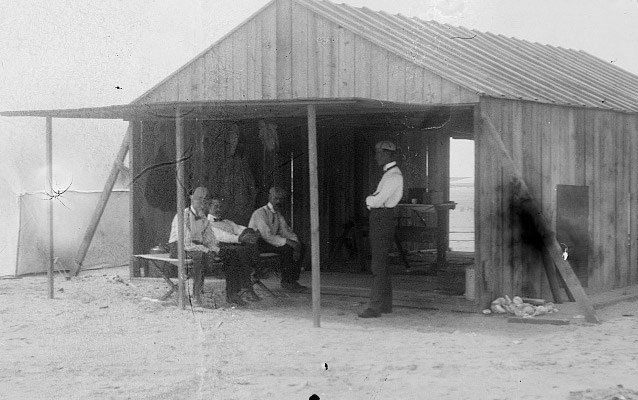
Caption: Chanute visits the Wrights at Kitty Hawk in 1901. Image Courtesy of the Library of Congress. Alt Text: Historic photo of four men standing in the shade of a wooden building.
Chanute’s final visit to Kitty Hawk was in November of 1903, roughly one month prior to the historic first powered flight achieved on December 17, 1903. The years following the 1903 flight presented a new set of challenges for the friendship. The brothers believed their flyer unique and needed to protect their invention which contrasted with Chanute’s open approach and clouded the nature of the relationship. Chanute offered consistent encouragement and publicity for their work and despite the later disagreements, Chanute was the Wright’s most important correspondent in the aeronautic community.
While disagreements drove the three men apart after 1905, the Wrights never forgot how important the friendship and inspiration of Octave Chanute had been during those early years. When Chanute died in 1910 Wilbur attended the memorial service and wrote the eulogy read at the Aero Club of Illinois in 1911. “His labors had vast influence in bringing about the era of human flight,” Wilbur Wright observed after Chanute’s death. “No one was too humble to receive a share of his time. In patience and goodness of heart he has rarely been surpassed. Few men were more universally respected and loved.”
Sources:
- loc.gov, Articles and Essays, Wilbur and Orville Wright Papers at the Library of Congress, The belief that flight is possible to man.
- Progress in Flying Machines, Preface, Octave Chanute, New York: Dover, 1899/1984
- Popular Mechanics, The Death of Octave Chanute, January 1911, p38
- Journal of the Western Society of Engineers, May 1911, In Memoriam Octave Chanute. P:438-445
- lib.niu.edu, Octave Chanute, The Chicago Connection, and the Birth of Aviation by Roger Launius.
- On Wind's Wings, Octave Chanute and the Indiana Dunes; Nick D'Alto, Traces, Vol. 15 No. 2, Indiana Historical Society, 2003.
- Locomotive to Aeromotive: Octave Chanute and the Transportation Revolution; Simine Short, 2014
- Gliding to Success. Flight pioneer Octave Chanute earned his wings at Dunes. Scott Roberts. Outdoor Indiana, Fall 2022.
- Flight Not Improbable: Octave Chanute and the Worldwide Race Toward Flight, Simine Short, 2023
